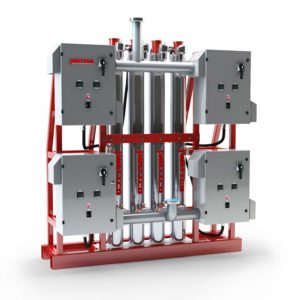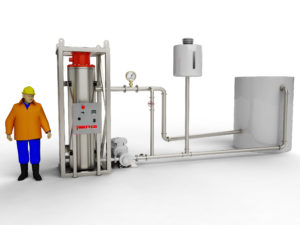Why use a Circulation Heater?
Last updated on February 1st, 2024 at 08:03 pm
Circulation heaters are used in the process heating industry to raise the temperature of circulating fluids. Wattco offers a wide range of designs for heating a variety of fluids at a range temperatures and flow rates. A number of customizations can be implemented to meet unique needs in a number of industries.  While the design elements vary depending on the application, the basic construction of a circulation heater typically consists of a flanged immersion heater mounted within a steel vessel. Insulating the vessel reduces the amount of heat lost in transfer. As well, the flange heater is removable to accommodate the need for maintenance or replacement. An inlet valve located near the flange and outlet valve at the opposite end of the vessel allow fluids to pass in and out of the heater.
While the design elements vary depending on the application, the basic construction of a circulation heater typically consists of a flanged immersion heater mounted within a steel vessel. Insulating the vessel reduces the amount of heat lost in transfer. As well, the flange heater is removable to accommodate the need for maintenance or replacement. An inlet valve located near the flange and outlet valve at the opposite end of the vessel allow fluids to pass in and out of the heater.
To heat a medium, fluid is pumps from the source into the inlet valve then through the circulation heater elements. Depending on the medium, gravity can generate the flow. In most cases, however, pumps push fluids through the heating chamber. The watt density of the heating element drives the amount of energy that the flange generates. Choosing a watt density that is too high for a given application can lead to damage of the medium. Once the fluid flows through the inlet valve and heating chamber, it exits the circulation heater through the outlet valve to its final destination.
Circulation Heater Design
In considering a design for a circulation heater, it’s important to consider the medium as well as the heating needs. The pH, viscosity, and flow rate of the medium along with the operating temperature drive the major elements of the design. The steel vessel, the flanged immersion heater, and the watt density of the flanged heater are just a few of the design elements that are adjustable depending on the application.
 Once a design has been established and the circulation heater has been fabricated, installation is straightforward. Orientation of the heater when mounting should take into account the target medium. If the medium is liquid or low-temperature gas, mount the circulation heater vertically with the flange pointed up. For gas or liquid heating at moderate temperatures, mount the heater horizontally. When heating gases at high temperatures, mount the heater vertically with the flange pointed down. The orientation of the heater’s design ensures optimal flow during the heating process.
Once a design has been established and the circulation heater has been fabricated, installation is straightforward. Orientation of the heater when mounting should take into account the target medium. If the medium is liquid or low-temperature gas, mount the circulation heater vertically with the flange pointed up. For gas or liquid heating at moderate temperatures, mount the heater horizontally. When heating gases at high temperatures, mount the heater vertically with the flange pointed down. The orientation of the heater’s design ensures optimal flow during the heating process.
Nuclear power plants utilize circulation heaters regularly for process and chemical heating. A nuclear energy consortium contacted Wattco specifically to design a system for heating CO2 in a nuclear reactor. The Oklahoma customer was heating gas at extremely high temperatures and needed a system with a controlled, measurable heat output. Wattco collaborated with the customer to design a custom heater that included thermocouples at the outlet valve, an SCR temperature controller, and a high limit controller to ensure temperatures remained below a certain safety threshold. Following installation, Wattco remained in contact with the consortium for three months providing system monitoring and technical support.
Wattco Circulation Heaters
Circulation heaters are powerful tools in the process heating industry; it is critical that they be robust, easy to maintain, and consciously designed for the application. Whether providing a pre-existing design or building a custom heater, Wattco has a commitment to providing the right product for the job.
